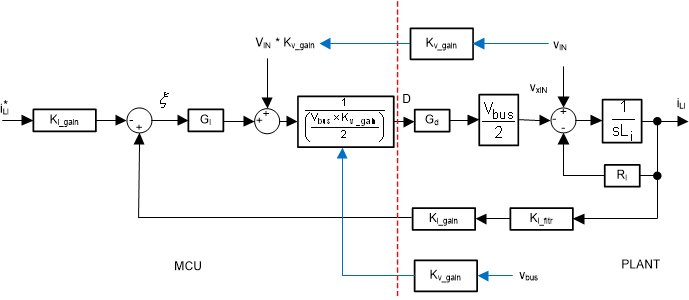TIDUFB1 December 2024
- 1
- Description
- Resources
- Features
- Applications
- 6
- 1System Description
-
2System Overview
- 2.1 Block Diagram
- 2.2 Design Considerations
- 2.3 Highlighted Products
- 2.4
Hardware Design
- 2.4.1 Inductor Design
- 2.4.2 Bus Capacitor Selection
- 2.4.3 Input AC Voltage Sensing
- 2.4.4 Output DCBUS Voltage Sensing
- 2.4.5 Auxiliary Power Supply
- 2.4.6 Isolated Power Supply
- 2.4.7 Inductor Current Sensing
- 2.4.8 Gate Driver
- 2.4.9 Isolated Temperature Sensing
- 2.4.10 Overcurrent, Overvoltage Protection (CMPSS)
-
3Hardware, Software, Testing Requirements, and Test Results
- 3.1 Hardware Requirements
- 3.2
Software Requirements
- 3.2.1 Getting Started GUI
- 3.2.2
Getting Started Firmware
- 3.2.2.1 Opening the Project Inside Code Composer Studio™
- 3.2.2.2 Project Structure
- 3.2.2.3 Test Setup
- 3.2.2.4 Running Project
- 3.3
Test Results
- 3.3.1 IGBT Gate Rising and Falling Time
- 3.3.2 Power On Sequence
- 3.3.3 PFC Started by GUI
- 3.3.4 Zero Crossing Under 380VAC, 9kW
- 3.3.5 Current Ripple Under 380VAC,10kW
- 3.3.6 10kW Load Test With Grid Power
- 3.3.7 9kW Load Test With AC Power Source
- 3.3.8 Power Analyzer Results
- 3.3.9 Thermal Performance
- 3.3.10 Voltage Short Interrupt Test
- 3.3.11 Efficiency, iTHD, and Power Factor Results
- 4Design and Documentation Support
- 5About the Author
2.2.1.2 Current Loop Model
To understand the current loop model, first closely look at the inductor current. In Figure 2-4 the duty cycle D is provided to the PWM modulator, which is connected to the switches Q1 and Q2. Remembering this, see Equation 1:
When D is set to 1, all the switches are off, and when D is 0, all switches are on, which connect the inductor to the point to M.
To modulate the current through the inductor, the voltage vxiN is regulated using the duty cycle control of the Q1 and Q2 switches. Assuming the direction of current is positive in the direction from the AC line into the rectifier and using the DC bus feedforward, the input AC voltage feedforward along with the assumption that the grid is fairly stiff. The current loop can be simplified as shown in Figure 2-4, and the current loop plant model can be written as in Equation 2.
where
- Kv_gain is the inverse of the maximum voltage sensed that is 1/Vmax_sense for the bus and the AC input. Assumed the AC voltage maximum sense and the DC Bus voltage maximum sense are equal.
- Ki_gain is the inverse of the maximum AC current sensed.
- Ki_fltr is the response of the RC filter connected from the current sensor to the ADC pin.
- Gd is the digital delay associated with the PWM update and digital control.
- iLi* is the current command, iLi is the actual inductor current.
- Vbus/2 is the voltage across one of the output bus capacitor.
- Zi is the impedance of the inductor which includes inductance Li and resistance Ri.
- Hp_i is the current loop plant as seen by the digital controller Gi.
- viN is the instantaneous AC voltage at the input.
 Figure 2-4 Current Loop Control
Model
Figure 2-4 Current Loop Control
ModelThe negative sign on the reference is in place because the current loop is thought to be regulating the voltage vxiN. To increase the current, vxiN must be reduced and thus, the opposite sign for reference and feedback in Figure 2-4. This current loop model is used to tune the current compensator. A simple proportional controller is used for the current loop. The gain of the proportional gain is adjusted to make sure the system is stable.